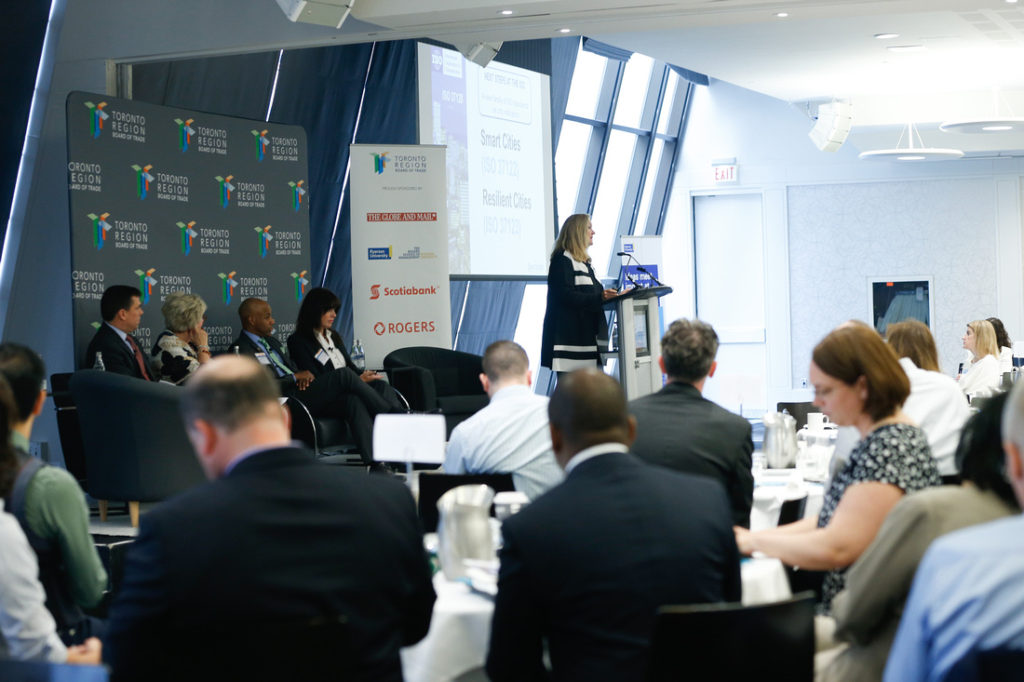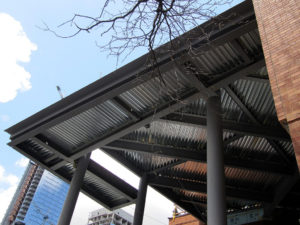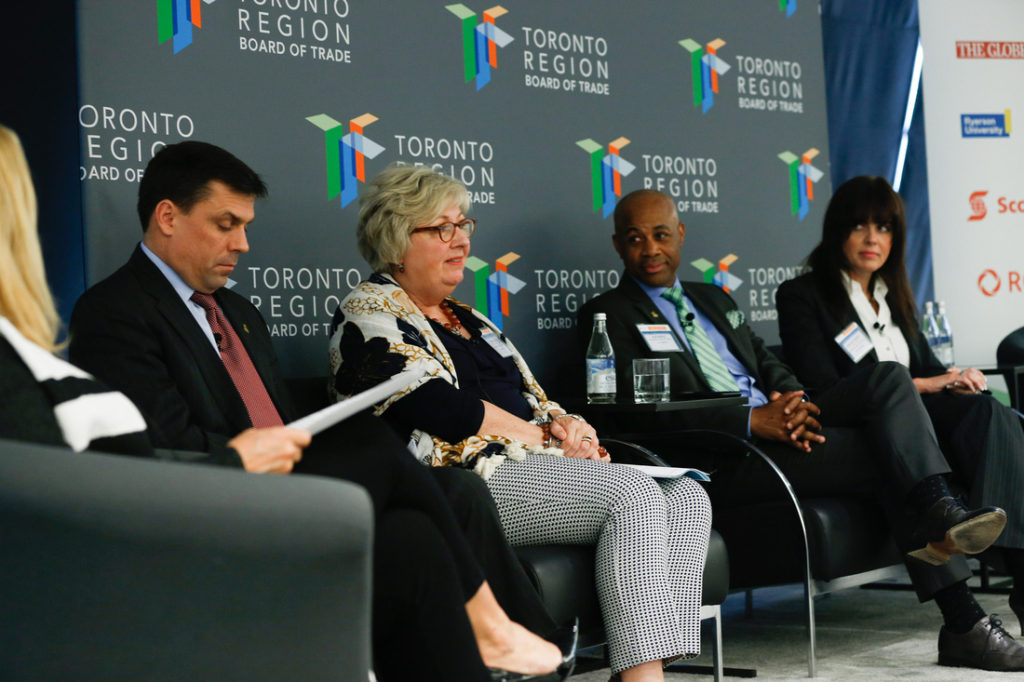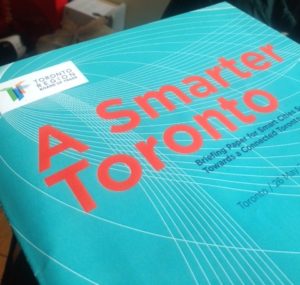
Even with new technology being revealed practically every week, the term “smart cities” remains widely undefined. When a city such as Toronto has achieved everything from economic success to cultural relevance, how does it make the jump from being just any city, to an ever-elusive smart city?
The best answer to this question is that such an expansive transition could take decades, however many would be surprised to learn that members of Toronto’s urban ecosystem have been considering these questions long before the Toronto Region Board of Trade’s first Annual Smart Cities Summit.
“I don’t really care about labels. I’m much more interested in what’s behind them. People have been talking about smart cities for more than 20 years.” said John Lung, the executive director of the intelligent community forum of Canada during a panel discussion at the Summit.
On stage with him are Chris Dwelley, the citywide performance manger of the City of Boston, David Amborski, of Ryerson University and Harout Chitilian, of the Montreal Executive Committee.
Ahead of this panel was the first keynote speaker Mark Kleinman, the director of economic and business policy for the Mayor of London, U.K.
“One of my passions is smart cities,” he said. “I’ve been a frequent visitor to Toronto for over 10 years, but I don’t think London or any other city around the world has all the answers to this agenda.”
When most people think of a smart city, an image of Tomrrowland comes to mind, potentially featuring drones, hover jets and robot dogs.
However, a smart city refers to using data and analytics to improve the overall function of the region. This includes using automation and the internet of things to make navigating the city easy for anyone with an internet connection.
Once a city has mastered its data, it will then be able to partner with organizations developing solutions to the issues indicated through the data. However, most cities don’t know where to start.
“Cities generally don’t know what their smart assets are, or even what makes human infrastructure smart,” said Kleinman.
The cities of London, Boston, Montreal, and others making strides in this space were represented at the conference and each came with a smart accolade to their name.
Boston, for example, can be credited with an initiative known as CityScore. CityScore is an online platform designed to inform the mayor how the city ranks in several areas at any given time by aggregating metrics from across the city into a single number.
“Our work really focuses on harnessing the power of data and technology to help the city deliver better services,” said Dwelley during his time on stage. He goes on to say that CityScore was built from a existing infrastructures, meaning data that was already available.
Furthermore, Kleinman focused heavily on Tech City, a cluster of technology companies that grew from a road interchange in East London which has increased the visibility of London’s tech scene over the years.
Where most cities are starting with this initiative is mobility, as Torontonians have observed with bated breath in our own city over the past few years. Not only has the city braved the acceptance and regulation of disruptive technologies like Uber, but it’s struggled to modernize its own transit systems.
However, as Kleinman articulated during his presentation, this kind of “productive” dialogue between the public and private sectors is inevitable.
“Yes, the governance is all wrong. Please just get over it. The governance is always wrong. Where do you want to be in five years?” said Kleinman indicating that innovation will always be ahead of the government because you can’t regulate something that doesn’t yet exist.
What about when something exists, but only a small portion of the population has access to it? That question is why the Board of Trade brought in some unexpected guests to share their insights about the digital divide.
When people think of innovation, disruptive technology, artificial intelligence and the internet of things, the Toronto Public Library doesn’t typically come to mind.
It would surprise many to find that Toronto’s well-established learning hub is also a bridge to some of the city’s most innovative technologies for those who wouldn’t otherwise be able to access them.
In a discussion about the global evolution of smart cities and the role of startups, scale-ups and city officials on facilitating that development, the digital divide was mentioned a grand total of two times. One of the questions facing city officials all over the world is, how can we ensure that everyone can participate in and benefit from these changes?
As Vickery Bowles, a city librarian at the Toronto Public Library, will tell you, a city where only a portion of the population has access to the latest technologies isn’t that smart.
Therefore, the Toronto Public Library announced last December that, funded by the City of Toronto, it would begin piloting a Lendable Hotspot program.
According to the Toronto Star, approximately 27 percent of city residents don’t have broadband internet access in their homes, meaning that “hot spots are a commodity.” Whether this has to do with the rising prices of broadband coverage or spotty coverage in under-serviced areas, it’s been made clear that a smart city that includes only a portion of the population isn’t living up to its name.
“Access to information and pathways to learning has been the great equalizer of the 20th century, but in the 21st century, access to technology is just as important,” said Bowles.
The Toronto Public Libraries are currently running three digital innovation hubs at the Toronto Reference Library, Fort York and the Scarborough Civic Centre, where citizens can conduct research for entrepreneurial ventures and explore ideas that they would be able to otherwise.
While it seems as if the internet has been around forever, it’s really only been 20 years since it began to significantly impact the world. It wouldn’t’ be reasonable for governments and populations to begin seeing internet access as a human right in what amounts to maybe 100 years in legislative time (we all know how slow institutional change can be).
That’s why city officials have set their sights on the internet first – so the city of Toronto can take advantage of its smart assets when the time is right. Eventually, should we have the resources, a smart city could mean vehicle to infrastructure communication, real-time business analytics, and essentially, knowing about issues before they manifest themselves in breakages, leaks and car accidents. In order for that to happen however, everyone needs to be connected to the internet.
The second mention of the digital divide came from Kristina Verner, the Director of Intelligent Communities at Waterfront Toronto. Intelligent Communities is the innovative division of Waterfront Toronto that offers Canada’s first open access, high speed broadband community network.
Verner emphasized the affordable and reliable nature of the coverage offered in the community, which will be operated by the Toronto-based telecommunications firm, Beanfield Metroconnect.
“Oftentimes in a smart city environment, you end up with an even bigger divide between the have and the have-nots. We’re making sure no one gets left behind.”
Initiatives other than the public library in Toronto that are attempting to involve citizens in their own wireless infrastructure include IdeaSpaceTO, a platform City officials seek feedback from the population about the challenges they’d like to overcome and Better Budget Toronto, an online outlet where citizens can access information about the city’s budget.
In the past few years, it’s become clear that megacities, rather than national governments, are going to be the most influential sources of change in the future. While Toronto may not be in the top five, it’s certainly in the top ten. By 2030, two thirds of the world’s population will live in cities, meaning they’ll need to find a way to accommodate their growing populations.
Based on the information available, it’s clear Toronto isn’t yet equipped to do this, seeing as the city’s maximized capacity was mentioned over and over again over the course of the summit.
However, the municipal government has made it clear that it’s having this conversation across several channels in an effort to keep up with its population and with its surrounding super-cities, which is definitely a start.
Maybe, just maybe, there’s hope for a smarter Toronto after all.
Image credit: Wikicommons – Chris McPhee
MobileSyrup may earn a commission from purchases made via our links, which helps fund the journalism we provide free on our website. These links do not influence our editorial content. Support us here.






